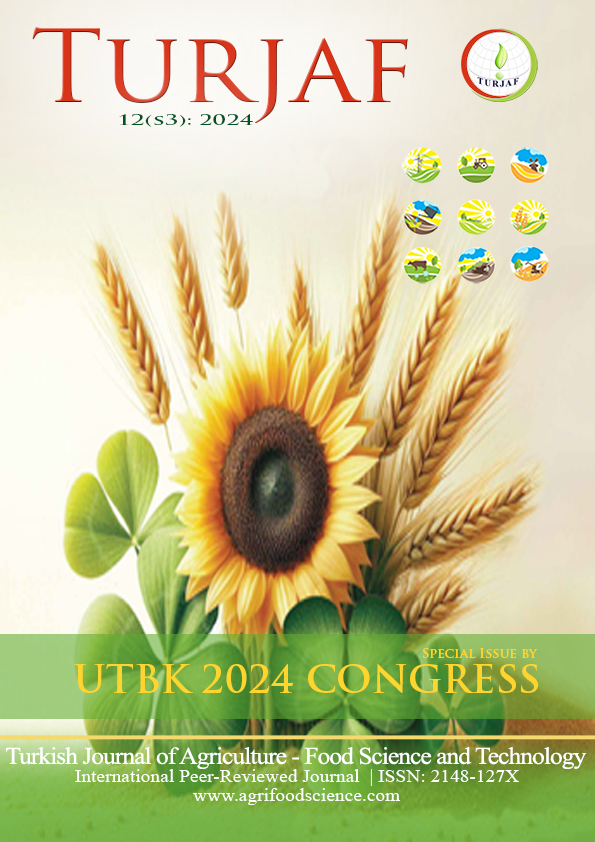Response of Barley Cultivars with Different Growth Habit to Vernalization Periods
DOI:
https://doi.org/10.24925/turjaf.v12is3.2742-2748.7237Keywords:
Heading time, Stem elongation, Rapid generation advance, Hordeum vulgare, VernalizationAbstract
Vernalization is the need for low temperatures during the early developmental stages in some plants. These plants need to stay at low temperature for a certain period of time in order to make the transition from vegetative to generative stage. This study was conducted to determine the responses of some barley cultivars to vernalization treatments. In the present study, four winter, two alternative and two spring in barley cultivars were used. The experimental design was factorial with three replicates. Germinated seeds of barley varieties were vernalized in small containers containing peat at 2°C for 0, 4, 5 and 6 weeks. Developing seedlings were transferred to pots and grown at a constant temperature of 22°C in 22 hours day/2 hours night. Jointing, heading time, maturity time, number of fertile tillers, number of grains per spike and thousand grain weight were evaluated. The effect of vernalization treatments on all the characters examined varied significantly according to the varieties. The winter cultivars Sladoran, Alba, Dicktoo and Aydanhanım did not head without vernalization. Considering the heading time of these cultivars, it was determined that four weeks of vernalization application was sufficient. In the alternative cultivars Tokak 157/37 and Kearney, four weeks of vernalization resulted in earlier heading of 9 and 40 days, respectively. In spring cultivars, vernalization application did not result in a significant change. Considering the time elapsed during vernalization application, four weeks of vernalization is the most appropriate period for all winter cultivars. Since the vernalization application for alternative cultivars is variable depending on the genotype, it is necessary to determine the vernalization periods in case they are used in breeding programs.
References
Alkan, F., & Kandemir, N. (2015). Tokak yerel arpa çeşidi içinden seçilen safhatların bazı gıda, yem ve tarımsal özellikler bakımından varyasyonları. Tarla Bitkileri Merkez Araştırma Enstitüsü Dergisi, 24(2), 124-139.
Abdul Fiyaz, R., Ajay, B. C., Ramya, K. T., Aravind Kumar, J., Sundaram, R. M., & Subba Rao, L. V. (2020). Speed breeding: methods and applications. Accelerated Plant Breeding, Cereal Crops, 31-49. https://doi.org/10.1007/978-3-030-41866-3_2
Bazzaz, M. M., Hossain, A., Khaliq, Q. A., Karim, M. A., Farooq, M., & Teixeira da Silva, J. A. (2019). Assessment of tolerance to drought stress of thirty-five bread wheat (Triticum aestivum L.) genotypes using boxplots and cluster analysis. Agriculturae Conspectus Scientificus, 84(4), 333-345. https://hrcak.srce.hr/228922
Cha, J. K., O’Connor, K., Alahmad, S., Lee, J. H., Dinglasan, E., Park, H., Lee, S. M., Hirsz, D., Kwon, S. W., Kwon, Y., Kim, K. M., Ko, J. M., Hickey, L. T., Shin, D., & Dixon, L. E. (2021). A new protocol for speed vernalisation of winter cereals. bioRxiv, 2021-https://doi.org/10.1101/2021.12.01.470717
Cha, J. K., O’Connor, K., Alahmad, S., Lee, J. H., Dinglasan, E., Park, H., & Dixon, L. E. (2022). Speed vernalization to accelerate generation advance in winter cereal crops. Molecular Plant, 15(8), 1300-1309. https://doi.org/10.1016/j.molp.2022.06.012
Fernández-Calleja, M., Casas, A. M., & Igartua, E. (2021). Major flowering time genes of barley: allelic diversity, effects, and comparison with wheat. Theoretical and Applied Genetic. 134, 1867–1897. doi: 10.1007/s00122-021-03824-z
Freed R., & Eisensmith S. P. (1986). MSTAT - Statistical Software for Agronomists.
Agronomy Abstract.
Kandemir, N., & Saygılı, I. (2023). Evaluation of a barley (Hordeum vulgare) chromosome 2 drought tolerance quantitative trait locus in genomic backgrounds of two cultivars. Plant Breeding, 142(2), 211-222. https://doi.org/10.1111/pbr.13076
Kandemir N., Saygılı I., Sonmezoglu Ateş, O., & Yildirim, A. (2022). Evaluation of barley semi-dwarf allele sdw1.d in a near isogenic line. Euphytica 218(3), 31. https://doi.org/10.1007/s10681-022-02983-4
Karsai, I., Szucs, P., Meszaros, K., Filichkina, T., Hayes, P.M., Skinner, J.S., Lang, L., & Bedo, Z. (2005). The Vrn-H2 locus is a major determinant of flowering time in a facultative x winter growth habit barley (Hordeum vulgare L.) mapping population. Theoretical and Applied Genetic. 110, 1458–1466. https://doi.org/10.1007/s00122-005-1979-7
Laurie, D. A. (2009). Developmental and reproductive traits in the Triticeae. Genetics and Genomics of the Triticeae, 591-609. http://dx.doi.org/10.1007/978-0-387-77489-3_20
Ochagavia, H., Kiss, T., Karsai, I., Casas, A. M., & Igartua, E. (2022). Responses of barley to high ambient temperature are modulated by vernalization. Frontiers in Plant Science, 12, 776982. https://doi.org/10.3389/fpls.2021.776982
Sasani, S., Hemming, M. N., Oliver, S. N., Greenup, A., Tavakkol-Afshari, R., Mahfoozi, S., Poustini, K., Sharifi, H.R., Dennis, E.S., Peacock, W.J., & Trevaskis B., (2009). The influence of vernalization and daylength on expression of flowering-time genes in the shoot apex and leaves of barley (Hordeum vulgare). Journal of Experimental Botany, 60(7), 2169-2178. https://doi.org/10.1093/jxb/erp098
Sanna, G., Giunta, F., Motzo, R., Mastrangelo, A. M. & De Vita, P. (2014). Genetic variation for the duration of pre-anthesis development in durum wheat and its interaction with vernalization treatment and photoperiod. Journal of Experimental Botany, 65(12), 3177-3188. https://doi.org/10.1093/jxb/eru170
Saygılı, I. (2023). Barley yield and malt quality affected by fall and spring planting under rainfed conditions. PeerJ, 11, e15802. 10.7717/peerj.15802
Saygılı, I., & Kandemir, N. (2021). Variations inspike traits among pure lines selected from a barley landrace. Levantine Journal of Applied Sciences, 1, 15-20. https://doi.org/10.56917
Zadoks, J. C., Chang, T. T., & Konzak, C. F. (1974). A decimal code for the growth stages of cereals. Weed Research, 14, 415-421.
Von Zitzewitz, J., Szűcs, P., Dubcovsky, J., Yan, L., Francia, E., Pecchioni, N., Casas, A. , Chen Tony H. H. , Hayes P. M., & Skinner, J. S. (2005). Molecular and structural characterization of barley vernalization genes. Plant molecular biology, 59, 449-467. https://doi.org/10.1007/s11103-005-0351-2
Zheng, Z., Wang, H. B., Chen, G. D., Yan, G. J., & Liu, C. J. (2013). A procedure allowing up to eight generations of wheat and nine generations of barley per annum. Euphytica Journal, 191, 311-316. https://doi.org/10.1007/s10681-013-0909-z
Downloads
Published
How to Cite
Issue
Section
License
This work is licensed under a Creative Commons Attribution-NonCommercial 4.0 International License.

























